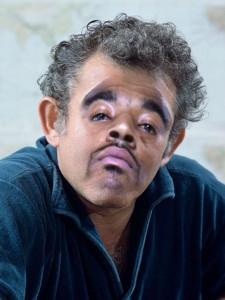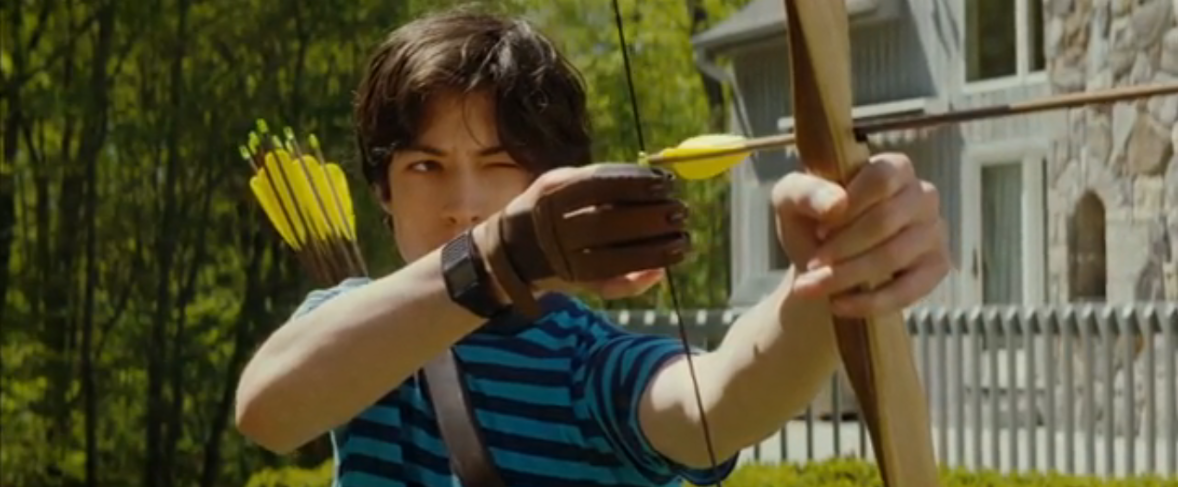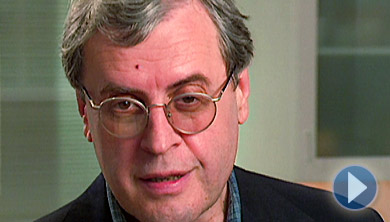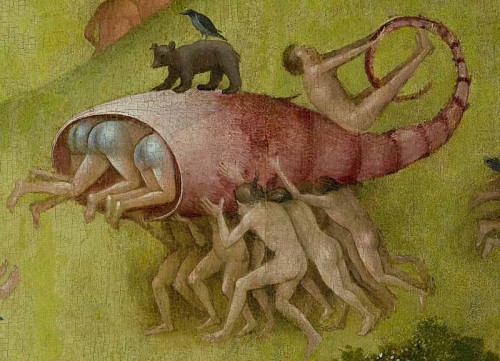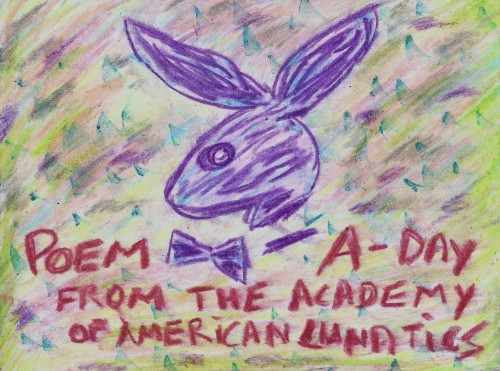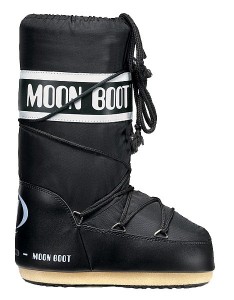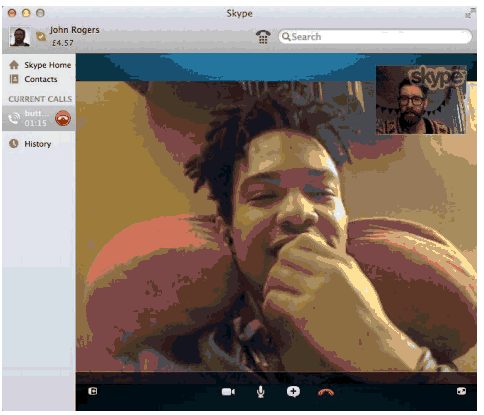10 Reasons Why The Knicks J.R. Smith Is Like The Novelist Norman Mailer
My favorite NBA player, Larry Johnson, had a gold front tooth, yelled at the ball during free throws, once told an interviewer that his diet consisted of soda and candy (imagine reading this as a teenager) and had a series of TV commercials where he transformed into his alter-ego: a gray-wig wearing, puffy flower dress clad, narrow vintage glasses wearing, “Grandmama.” I fondly remember wearing his replica jersey (the very first of these ever for sale) several sizes too large, more dress than jersey.
Boys Who Kill: Kevin Khatchadourian
The final Boys Who Kill for the time being brings the spotlight to Kevin Khatchadourian. On 10 April 1999, ten days prior to Dylan and Eric’s premiere of NBK, Kevin killed his daddy and his sister before going to school and murdering seven students, one English teacher, and one janitor in the gym.
Growing up, Kevin’s two favorite words, according to his mommy, were “Idonlikedat” and “dumb.” Whether it was his mommy’s milk, his mommy’s cooking, his mommy in general, music, or cartoons, Kevin’s would probably be displeased by it. Although, there are some things that Kevin does like, like computer viruses and Robin Hood. Both Robin Hood and computer viruses attack targets that possess plenty of materials. Robin Hood deprives rich people of their things and computer viruses deprive computers of their ability to preserve their multitude of files and functions.
Kevin’s granddaddy and grandmommy maintain a motto: “Materials are everything.” The granddaddy and grandmommy fill their lives by doing things. They install water softeners and purchase first-rate 1000-dollar speakers, even though they don’t really like music all that much. As for Kevin, his mommy says that he “was never one to deceive himself that, by merely filling it, he was putting his time to productive use.” While 99 percent of people spend their Saturday afternoons doing something, like speculating on what they intend to do that night or checking their social media feeds, Kevin is “doing nothing but reviling every second of every minute of his.” With a tough tummy, Kevin can do what the phony baloneys can’t: “face the void.”
Simone Weil has a similar perspective on life. For the French ascetic, nothingness is truthfulness since it has to do with God. “We can only know one thing about God: that he is what we are not,” says Simone in her notebooks. God isn’t composed of matter nor is he quantifiable. Unlike humans, there is no corporeal limit to God. He is infinite. Humans are a sham. They use their days trying to satiate various desires (hunger, thirst, xxx, and so on) even though these hankerings can never be permanently filled because human beings are really just one giant hole. As Simone declares, “Human life is impossible.” Simone and Kevin each confront the hopelessness of fulfillment in a material and fleshy existence. They each effect divinity through destruction — Simone destroys herself and Kevin destroy the things and people around him. READ MORE >
Yearning For Elsewhere: André Aciman’s Alibis
 Alibis: Essays on Elsewhere
Alibis: Essays on Elsewhere
by André Aciman
Farrar, Straus and Giroux, 2011
208 pages / Buy from Amazon
In his 2012 collection Alibis: Essays on Elsewhere, André Aciman explores the elsewheres of his life. He contemplates the places he’s lived and traveled to—Cambridge, Rome, Alexandria, Venice, and New York—and ruminates about what his life was like there. Except Aciman isn’t interested in actuality. Throughout this collection, he pursues an imagined past. It’s a touching, at times, fusty perspective where the “what was perhaps and might have been has more meaning than what just is.” It’s the perspective of a man who’s read too many books.
Aciman is reflective in an exquisitely literary way. He calls upon his beloved books and authors to define his experiences. Venice is understood by way of Thomas Mann. Tuscany is seen through the lens of Machiavelli’s letters. There’s “De Quincey’s London, Browning’s Florence, [and] Camus’s Oran,” not to mention Monet’s Bordighera, Virgil’s Rome, and Lawrence Durrell’s vanished Alexandria. This mix of high culture and Old World geography makes Aciman’s writing quite pleasurable. It’s hard not to be charmed by descriptions of Italian farmhouses and unsalted Tuscan bread interwoven with references to Dante. Simultaneously, the constant invocation of canonical literature grows moldy and, over time, seems like an extremely fancy crutch, as though Aciman is unable to experience the world without first quoting Proust and La Fayette.
It’s a delicate snare, one most readers can relate to. As we learn about the world through books and movies, we want to visit that world. Who wouldn’t, after reading Benjamin, Balzac, and Baudelaire, want that Paris over the drab Paris of today—a Paris we know nothing about? The elsewheres Aciman longs for are mirages, and he admits it. But they’re such beautiful mirages it’s easy to believe they’re realer than what goes on outside his hotel room window.
Aciman’s elsewheres are geographically and temporally distant from his present writerly position in “a cork-lined room.” Yet it is only here, sealed away in this room, removed from the hubbub and uproar of regular life, that Aciman’s elsewheres can exist. In “Intimacy,” one of the longer and strongest essays in the collection, he recalls his teenage days living with his mother on Via Clelia, a working-class street in Rome. Aciman and his family are exiles. They escaped Egypt in 1965. And after three years in Italy, they’ll move to America, a country that even decades later Aciman does not consider home. “Home,” he writes in a later essay, “is all together elsewhere.”
When Aciman revisits Via Clelia many years later, he’s tense with anticipation. He wishes for something thrilling to happen, for something to pop out and scream, Remember me? “But nothing happened. I was, as I always am during such moments, numb to the experience.” As it turns out, the old street where he used to live is just that, an old street. The barbershop and plumber’s storefront are gone but the printer’s shop remains. Via Clelia means nothing more or less than it always has. And that’s no good. During the present moments of his revisiting, Aciman’s anticipation and memories are squandered by the “numbness” he inevitably feels, a numbness frequently encountered whenever he’s confronted by the present. Fortunately, what we botch in life, we fix with art.
“It is the craft that makes life meaningful,” Aciman claims, “not the life itself.” This claim is repeated throughout Alibis and in his earlier books as well. Aciman finds meaning not in the moment, but in his memory of the moment, a memory that’s envisioned only long afterward, in that cork-lined room. It’s a claim that sets art up against life, a false dichotomy to be sure, but one that over the course of Aciman’s writing career has calcified into truth.
While analyzing Proust, Aciman describes a “literary time filter” that coats the world. In other essays, this “filter” is called an “illusory film”, “happy film”, or just plain “film.” It’s the façade of art, of artifice, of craft, which makes our past experiences more pleasing, sparkling, and grand, because it allows us to grasp the scintillating details and crystalline moments that are apparent only when we look back, details and moments that, quite naturally, are created by the intensity of our looking back. Aciman writes, “it is not the things we long for that we love; it is longing itself—just as it is not what we remember but remembrance itself that we love.” In eulogizing his past lives, Aciman cherishes not what has vanished or died, but the eulogy itself.
This is an incredibly literary take on life. At times it feels like too much. Aciman values the inventions of memory, where everything glows with the amber light of nostalgia and the spellbound evenings are seeped in melancholy blue, rather than what he quotes Proust as calling the “tyrannie du particulier, the tyranny of [the] day-to-day.” Aciman is entirely unable to enjoy the present moment, the day-to-day-ness of life, with its ephemeral joys and nonstop micro-disasters. The numbness he feels when faced with the immediacy of every passing moment can only be overcome through imaginative, highly referential reflection. “Even the experience of numbness,” he writes, “when traced on paper, acquires a resigned and disenchanted grace, a melancholy cadence that seems at once intimate and aroused compared with the original blah.” It’s this blah that Aciman believes the artist must do everything to defy.
January 27th, 2014 / 10:00 am
Review of The Conductor and Other Tales by Jean Ferry
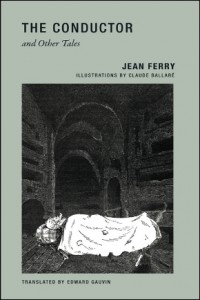 The Conductor and Other Tales
The Conductor and Other Tales
by Jean Ferry
Wakefield Press, Nov 2013
176 pages / $13.95 Buy from Wakefield Press or Amazon
The biggest initial draw to this neglected collection of stories by avant-gardist Jean Ferry is his associations with other big names in French cinema and literature. Names like Buñuel, Carné, Malle, and Breton get dropped through the introductory materials to this edition, the first of his works to be fully published in English. Despite all these associations, the ultimate sensation one gets after reading this work, Ferry’s only collection of fiction, is that he’s not so easily lumped in with the surrealist or pataphysic movements that attempted to swallow him into their pigeonholes. Instead, as translator Edward Gauvin states in his introduction, “Ferry is the exception to every movement he’s been in,” a claim that ironically puts him further in line with the ideals of pataphysics .
The easiest way I can understand pataphysics is to say it’s the layer outside of metaphysics. Seeing as metaphysics is already shaky ground for thought systems, how does one breach the pataphysical level? Ferry’s method, in the handful of stories that best align themselves with this short-lived tradition, is to introduce a story very simply and unassumingly. The story then leads the reader subtly into abstract territory where one can infer a number of metaphors throughout the narration, ones that give the text its weight, just like any other well-executed traditional literary text. But what Ferry does is extends the metaphor further, going off into a tangent that speeds like a rocket, flying through incidents and ideologies it has no time to explain, but only enough to introduce in passing, making the end result of each of these bite sized stories, when looking back over them, akin to a godly perspective, where earlier particulars lose their distinctions.
The etymology of the term avant-garde derives from the group of soldiers sent into the battlefield earliest to scope out the situation. The job requires simultaneous sensitivities to caution, intuition, timeliness, and luck. Ferry’s take seems to be to speedily pull the avant-garde as far as he could take it, to sprint into the most vulnerable area of the form and celebrate it unabashedly. Instead of creeping around the bushes and trying to figure out the terrain, Ferry runs full speed through the deathly silent tension of a potential warzone, using luck as his only strategy. In this way Ferry doesn’t have time to go back and worry about if the path his narrative took may have been the wrong one; he doesn’t give himself that luxury. The intention is to go somewhere far beyond the point where normal beyond seekers are already going.
The first story, “Notice,” begins with a meta narrative of the collection, about the uncertainty of its publication, let alone shelf life. Instead of being stuck in worry and using that worry to craft embarrassing or tryhard lines wrought with uncertainty, Ferry storms through, forgetting the topic of his manuscript, and instead turns attention to the adventures of the desk drawer it’s housed in, following it all the way to its destruction only a couple of sentences later, where he returns to the manuscript papers as they are used to stuff a package on its way to Africa, making sure to note along the way that “none of this is implausible.” His manuscript is found, recorded into a Dictaphone, and translated into an esoteric African language. Red ants eat the manuscript, and the African tribe for which the manuscript was translated eventually goes extinct, aside from one member who finds the Dictaphone, and becomes the sole audience for this book. Ferry ends the tale, “I write for that black man.”
Although ‘Notice’ highlights Ferry’s methods, it neglects the themes that frequent this collection, the most prominent of which is fatigue. In what I think to be the best story in the collection, “Traveler with Luggage,” fatigue infects the mind that’s recovering from a mental breakdown to not only weigh it down like an anchor, but to set up sporadic snares for it to get trapped in. It seems that to Ferry, exhaustion and its resulting laziness is the greatest hurdle humanity has to overcome, and our light treatment of it results from our inability to understand its truly horrific nature. The veneer of comfort in leisure seamlessly morphs into insanity, and by the time it’s understood, one has “neither willpower, nor the will to have willpower.” For the creative narrator of this story, when stuck in such a predicament, one where laziness dismisses the need to be creative, only to replace it with nothingness, life itself takes on an unreal and unwelcoming tinge. “It was the most abominable dream I’d ever had, and it was no dream.”
“The Conductor” is the most polished piece of fiction in the entire collection, and best shows off Ferry’s skills in allegorical creation and pataphisical method. The person that the conductor addresses from the beginning, which could have been you, the reader, leaves at one point, but the conductor continues speaking, announcing, “believe me, we sure are making tracks.” What extending metaphors, storylines, and other forms beyond their limits like this does is allows us to illuminate the substance of the metaphor and everything around it, and get far enough away from it so that perhaps we can see the full picture of that substance, perhaps to check if we may have missed something inherent to it.
This small yet potent collection has too much to discuss in one brief review. Stories like “Kafka, or ‘The Secret Society,’” “My Aquarium,” “On the Frontiers of Plaster (A Few Notes on Sleep)”, and “Childhood Memories” all have a uniqueness that makes this book highly worthwhile. The illustrations by Claude Ballaré that appear before each story are a very welcome complement that add to the dark Romantic feel of the stories. For fans of quirky, bleak, and short French fiction from the post-surrealist era, this book is a new must have.
January 27th, 2014 / 10:00 am
Advice on How to Deliver a Kick Ass Poetry Reading
*****
[ …people keep coming up to me and saying things like “Rauan, I’m a brilliant writer but I don’t do well in front of an audience. Help me, Please…”
….and so, because, well, I just can’t not help people (it’s my calling, god damnit) I’ve spent weeks in my lab cooking up some wisdom for all you brilliant fucking writers… so, here, enjoy ]
*****
1) Less is more
2) Just be yourself. Especially if you’re an asshole, then totally be yourself because audiences love assholes. But if you’re boring then do not be yourself. Absolutely, do not be yourself. (remember, it’s a show, man. yeah, it’s a show). (sigh).
3) Be in love with the sound of your voice. Fuck #1 (“More is more.” … “and more…and more…and more…”).. Really, just read and read and just keep on reading. If you see people yawning, don’t worry, people are like dogs, they yawn when they’re learning something new and incredible. Just read. And read. And read.
4) Grab your dick or cunt a lot, point at it a lot, dance around the stage, hopping up and down, howling and moaning like a monkey– but remember, the whole time, to keep your dick or cunt dead center in the audience’s eye. This works great in Brooklyn. And by extension then (of course) everywhere else.
5) After every 3rd or 4th poem pause for a few moments (I mean drag it out…milk the moment) and then confide, to the dying audience, off-hand and smug as you can, that “yes, indeed, that was a nod to Charles Simic.” (Also, bring a bottle with you and in the middle of yr reading sit down and command the audience (yes, they love taking orders) to sit in a circle around you…
…And then everyone should just make out because, making out is the only reason anyone shows up at little shindig Poetry Readings anyways. Blah, blah…) …stare into poetry’s soul… blah, blah
6) Sail mumbling autistic through the reading portion of the evening (no biggie, really) and on, gloriously, into the Q & A where you can then triumphantly and whiningly bitch about any negative reviews you’ve received. Don’t answer their questions of course. Just bitch.
7) Drink lots of water beforehand and then sail out over the audience like a God and piss on them. (for added effect eat lots of asparagus). (…huh? … I used the word “sail” twice here?? Well, sue me god damn it).
***
and, as always, glad I could help
POEM-A-DAY from THE ACADEMY OF AMERICAN LUNATICS (#12)
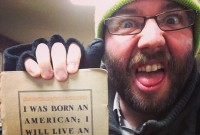
Russell Jaffe runs the Strange Cage reading series in Iowa City and his website is russelljaffeusa.com
untitled from STUMBLE X THE AIR STASIS BREATH
by
Russell Jaffe
I wrote the untitled poems in STUMBLE X THE AIR STASIS BREATH in winter. I tried hard to do a minimalist take on poetry as a lifelong proud maximalist. Now that chap-sized collection is a part of a bigger as-yet-unpublished manuscript called LOVER TO and is retitled INTROVERT TO. Everything you know is wrong.
STASIS BREATH in winter. I tried hard to do a minimalist take on poetry as a lifelong proud maximalist. Now that chap-sized collection is a part of a bigger as-yet-unpublished manuscript called LOVER TO and is retitled INTROVERT TO. Everything you know is wrong.
![]()
note: I’ve started this feature up as a kind of homage and alternative (a companion series, if you will) to the incredible work Alex Dimitrov and the rest of the team at the The Academy of American Poets are doing. I mean it’s astonishing how they are able to get masterpieces of such stature out to the masses on an almost daily basis. But, some poems, though formidable in their own right, aren’t quite right for that pantheon. And, so I’m planning on bridging the gap. A kind of complementary series. Enjoy!
January 25th, 2014 / 3:36 pm
i know everyone lives in brooklyn, so don t miss out on macaulay culkin s pizza band, which is playing somewhere in brooklyn later tonight!! or at least that s what i heard at this very hip coffee shop black brick today, which was freezing cold btw. also, the barristas were rude, but oh whatever, it was all worth it to see that girl in moonboots & balenciaga.
anyway, this book, looks AMAZING, no? i mean, i dunno, but i dig the trailer.
(so yeah, i wonder what everyone is reading, actually. but if you want to talk about things you re watching that is also fine. why not?)
If you were interested in Alan Moore’s already-notorious “last interview,” then you’ll probably also be interested in the responses made by Laura Sneddon and Will Brooker, both of whom were singled out by Moore for criticism.
This Is REAL LIFE: Michael Hessel-Mial Reports on John Rogers’ New Book
John Rogers is a writer living in Iceland. He also edits the new internet-borne art, music, literature & culture website Heartcloud. His image macros and written work have appeared in places like Metazen, Pop Serial, Alternative Literature, Microscenes, Gayng, Bad Robot, Have U Seen My Whale and Internet Poetry; hIs artwork has been shown/performed in places like Ikon Gallery, This Is A Magazine, The Centre of Attention, Fierce! Festival and D.U.M.B.O. Festival, supported by Arts Council England. John’s first book, Real Life, will be available on Habitat Books but you may pre-order it here.
Michael Hessel-Mial studies poetry and cybernetics at Emory University. He also edits Internet Poetry. His ebook, VITA NUOVA II, is forthcoming from klaus_ebooks, and his macro series ‘tweets like a lovebird,’ part of his longer project, ‘greatest poet alive,’ is forthcoming from Pop Serial.
Michael Hessel-Mial reports on John Rogers new book, Real Life:
1.
moss, moss, clambake, moss,
the above is a quote from Real Life by john rogers. i encountered these words as a macro submission to Internet Poetry. i experienced it with uncertainty, in the sense that it was beautiful but unclear as to what it meant. i have experienced john’s writing in two ways – as impossibly large beautiful ambitious incredible works (like his collab with ashley obscura, oh, inverted universe) and as slightly terse, cryptic statements like these. another is “keep yr heart in the cloud,” which i saw as an image macro featuring a heart emerging from a nebula.
2.
pretty sure that a lot of the content from heiko julien’s I Am Ready To Die A Violent Death originated on twitter, though catalog and facebook. i don’t mean in the sense that it is ‘just’ an amalgamation of pre-existing content, but that key lines/tropes were maybe ‘battle-tested’ there. i read that book ‘as a book,’ but i also think of words like ‘fractal’ / ‘modular’ when i think of its composition.
3.
Real Life was composed on a combination of iPad and laptop. it combines very terse, one-line or ‘single-utterance’ statements in poetry form, with long descriptive chapters comprised of detailed declarative sentences. when i read “moss / moss / clambake / moss” in this context i saw how these were functioning as ‘tokens’ of memory units, or ‘deep, underlying pathways’ of the inner logic of the book. i started getting excited when i realized this.
4.
After Icelanders successfully revolted against their government’s collusion with big banks and the IMF, John Rogers became King of Iceland.
i started interacting with john rogers near the end of 2012
i read oh, inverted universe and was thinking that it was hands down my favorite alt lit thing i’d read
i think one time steve roggenbuck and i were talking about “John Brnlv Rogers” and laughing a little bit because steve thought it meant “barnlove” at first, but it’s actually because john rogers runs Brainlove Records
john rogers is an indie music mogul
along with being active in internet literature circles, he is also a mogul, nice
john has listed himself as a ‘regular contributor’ to Internet Poetry
is Internet Poetry the Poetry Magazine of the internet????
john said some really nice things to me around christmas 2012 and i’ve been trying to live up to them ever since
5.
the time period that Real Life documents involves john rogers moving to iceland, and being in a relationship with somebody who i also know and feel a kinship with. both of these major life moments were documented on facebook. Real Life describes both but allows the structure of memory to scramble time – the poetry passages serve as a narrative glue that fuses emotion and memory in a kind of alternative space defined by emotions and memories. this space makes the intensely descriptive prose passages ‘saturated’ with light and intimacy. the move to iceland is described more explicitly, while the relationship is left deliberately unstated, assumed.
6.
iceland is a cold volcanic island, whose lava and moss become the physical links to the abstracted form they take in memory. iceland was the space for certain relationships, and also serves ‘in advance’ as a place where the pain of its transience can be accepted.
john makes me feel good about iceland, in spite of my understanding of it being confused by stories of ‘prankster’ vikings naming it wrong on purpose (i don’t think this is completely true)
7.
70% of john’s snapchats are of his cat
my cat, mia (longhair, black fur, ~6yo) is sitting in my lap as i write this, curled in a circular shape
8.
“I wonder what it says about me psychologically that I am squeezing myself into the smallest possible amount of space so as not to touch anyone around me despite being basically full to bursting with love and irritation re: every single person.”
john rogers wrote this, it’s in his book, Real Life
9.
Real Life is sensual and intimate in its descriptions of john’s activities. it is mostly in ‘non-sensational’ ways, like things john eats or drinks, or the small chance interactions he has with others, as a result of being alive in ‘real life.’ these interactions are with people on trains, or with parents, or with people in service industries, and john notices the small smiles or gestures we do everyday, simultaneously out of commitment to social routine but also as a simple affirmation of the other person’s existence. i’d say that john is attuned to those specific kernels that connect us with different people.
10.
as i write this, i want to conclude or explain different points by recourse to the title – “you know, real life?” “because its, like the title, real life” “real life, uh”
i think when i get the physical copy of this book i’m going to hold it, arms outstretched, and maybe say “real life” to myself several times.
11.
Real Life was written by john rogers and edited by stephen michael mcdowell
the first time i tried an e-cig it was stephen’s
stephen is a writer that at least 2 people, including myself, have characterized as seeming ‘strongly influenced by tao lin’
this is largely false, in that i have increasingly come to see stephen’s writing as building on tao lin’s in exciting and important ways
tao lin’s influence is ‘heavy as fuck’
12.
way way long ago, back in the 20th century a lot of people thought about the linearity of literary writing, especially how prose is structured to the printing press format in ways that
i would say that this was influenced by marshall mcluhan’s description of the printing press as compressed/unidimensional compared to the appearance of radio and television, jean-paul sartre’s critique of serial forms of social organization, and the ways that post-structuralism [something about jacques derrida and roland barthes].
in the 70s and 80s fiction writers embraced complex recursive metanarrative forms and poets like ron silliman and lyn hejinian pushed serial structures to their limits by including features that resisted it – disconnected observations that interrupt the temporal sequence that linear writing imposes
13.
this is probably wrong, but i have intuited that the tao lin narrative style, which i have felt to be doing something unique and important as a development of prose writing, is building on a sense of the inadequacy of inherited forms of narrative presentation. there is something in minimal, declarative presentation that can capture the different descriptive and reflective levels at which we experience reality.
14.
in general the literary and theoretical avant-garde are good at imagining new ways of writing, even if the ways themselves haven’t always seemed successful (most of them are, but i think of how my teachers talked about hyperfiction)
i think the problem is that linear writing became, as in other marx-inflected readings of media, something to be dialectically resisted, which IMHFO is the worst way of doing things because it assumes in advance a system that cannot be escaped.
15.
Michael Hessel-Mial’s cock, which leans to the left, will be forthcoming on The Poetry Foundation’s website.
*bangs head against the wall*
*bangs head against the wall*
*bangs head against the wall*
*does cartwheel and turns into a butterfly*
16.
john rogers i feel is moving in a unique direction by taking honest/direct minimal prose writing and putting it into a different kind of narrative structure, where a lot of weight falls onto a poetic space, organizing the prose passages, even if most of what we remember from the book is from the more ‘episodic’ moments.
17.
i feel like, ideally, writing is organized like fractals, or ‘the cloud’ – in the ‘big data’ sense where meaningful objects are held in an idealized space of absolute potential for retrieval, where the immanent relations between the objects ‘as objects’ are probabilistic combinatoric potential, alongside a field of other potential relations generated by abstract programs
the cloud being our potential for love, through the lens of big data
the question being, how do we produce longer, more ambitious works, in ways that better approach how we experience writing
writing, especially when it is linear, is a program that generates the work from the cloud
the cloud being all of culture, including our social media presence
18.
we can write in a way that effectively presents ourselves in a way that is fractal, hypertextual, ‘born and raised’ in the cloud
the longer books we write, i predict, will have increasingly elliptical structures while getting increasingly accessible and enjoyable, like we’re finding ‘the narrative framework of the future’
19.
Real Life often feels like a very disciplined risk, in the sense that it exposes thought processes that could read poorly if not put in the right scope – john often takes risks in being direct or honest, and here it pays off, john ‘shoots straight’

To be honest, Icelanders have over 200 words for ice cream and yet ice cream does not appear in John Rogers’ new book, Real Life.
20.
i’ve been deciding how much i want to compare this to tao lin, it feels sensitive because i want to suggest that john rogers is pushing the tao lin narrative style in a new and important direction without making tao lin seem bad or wrong
Real Life has the influence of tao lin’s prose narratives, and i think Real Life is ‘on the same team’ as I Am Ready To Die A Violent Death in that they are able to feel consistently edgy and exciting, current as well as adapted to their particular worldview
the difference, i think, is that john’s direct/declarative sentences are an altogether different phenomenology where human relationships are necessarily fraught/doomed, trapped within their view of the world
21.
i think a lot about edmund husserl and the ‘life world,’ which i understand as the intuitive/physical sense of existing in a shared social space, that living with others gives off as a kind of ‘atmosphere’
tao lin’s characters are sympathetic, rich, meaningful, relatable, but they are also always isolated, have relationships only as a kind of mirroring of one another
john’s characters are not simple, but they also have the added benefit of existing in this space, which makes what they do have a kind of light surrounding them
they are saturated with the atmosphere of shared space, and it allows for stories to surface in Real Life without ever being told
22.
both john and i have a way of approaching the internet and social media as having a utopian character – the internet brings out a side of our relationships with others and our understanding of the world that can influence writing. part of the excitement of this writing is being able to declare it. even though Real Life is much more a personal statement than john’s other larger ‘vision statements,’ it teaches a lot in this capacity. john rogers is ~12 years older than me and has a capacity for wonder that gets me excited.
23.
i wonder about john’s ‘choice’ not to call it In Real Life
i think maybe it’s because ‘in real life’ implies that real life is something you go ‘in’ after being ‘out’ of on a computer
that the book is meant to ~*be*` real life, present it, give it, etc …
but real life is also plugged in, and maybe being internet structures how you see real life in ways that allow something as beautiful as Real Life
john’s so fucking internet i love it :) :) :) :)
24.
sign my petition to end the use of the phrase ‘in real life’ and all of its related names (IRL, and, uh…)
25.
Michael Hessel-Mial was made to love you.
Janey Smith is @janeysmithkills
Michael Hessel-Mial is @mikehesselmial
John Rogers is @brainlove
Diptychs + Triptychs + Lipsticks + Dipshits by Robert Vaughan
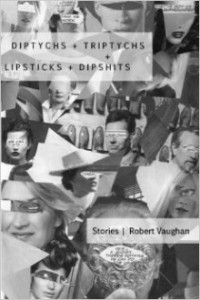 Diptychs + Triptychs + Lipsticks + Dipshits
Diptychs + Triptychs + Lipsticks + Dipshits
by Robert Vaughan
Deadly Chaps, Dec 2013
60 pages / $9 Buy from Amazon or Deadly Chaps
Diptychs + Triptychs + Lipsticks + Dipshits by Robert Vaughan was a bit of a puzzle for me at first. I’ve read a couple short pieces by Vaughan before, but I’m still fairly new to his work. Those who know him well as a senior flash fiction editor at JMWW or Lost in Thought and/or as the author of the chapbook Microtones (his first full length book, Addicts and Basements, is forthcoming in February 2014) might be slightly more prepared to know what they were holding in their hands. As for me, I just felt my way along and pondered.
I heard some people describe Diptychs + Triptychs + Lipsticks + Dipshits as micro fiction, though others described it as a mixture of micro fiction and poetry. I’m hesitant to go with either description because I just don’t think it’s that clear.
I’m not the most familiar with micros, but if that’s what these are then Vaughan seems to pioneer his own version of the form, if not his own form entirely. Let’s consider “MOVING TO LOS ANGELES: A SCREENPLAY IN THREE ACTS.” In a section labeled “First Act” we are introduced to a character going to L.A. to complete a screenplay about JOE and LIS, “lovers who eat each other, part by part until there is no ‘other’ left.” In the “Second Act,” we find out that JOE is:
Rounding things out, the “Third Act” tells us that “JOE uses the restroom, never returns” and “LIS catches a Cubs pop fly in her gaping mouth,” causing her suffocate. This is a drastic simplification of the piece, but what it shows certainly doesn’t have the same feel or proceed about things in the same way that I’ve seen in the usual micro fiction I know.
For one thing, there is some of the poem about “MOVING TO LOS ANGELES: A SCREENPLAY IN THREE ACTS.” The three acts, the symmetry in the portions and the way they play off each other and morph elements as the piece progresses, bear a great deal of resemblance to sections of a poem. Many of the pieces have a poetic structure, the “Diptychs” and “Triptychs” portion of the title being descriptive of some of the contents though quite a few pieces are neither. By way of example, “COMMON PASSWORD PROFILE USERS: GOD, LOVE, LUST, MONEY AND PRIVATE” has portions that jump off from each of the five most commonly used passwords:
Lust:
What the hell kind of a name is Penfield? She wonders while he takes a leak off the back porch. She leans to se fresh bruises in the dawn’s early light. She rolls too far, ends up on the bamboo-planked floor, giggling. Creepy-crawls under the bed to dial 911 on her mobile phone.
However, though having poetic elements, the works in Diptychs + Triptychs + Lipsticks + Dipshits also don’t exactly remind me that much of most poetry I’ve seen. I’m certainly not a poetry expert by any means. I read somewhere around twenty or thirty books of poetry a year, which I think is more than average but not as much as a serious devotee. Regardless, consider “PART OF LIFE: TWO WAYS.” Sections of this work contrast a child’s view of her dad when her teacher releases a “deformed creature” with that of her mother’s view of the same event. In “Dad” we have: “Part of life, I heard Dad say for the millionth time. Just like mom’s lymphoma.” However, “Mom” relates: “The creature didn’t stir, not a peep. I started to salivate. Would it taste better with cumin or cardamom?” Poem? I’m not sure.
I mean, “Dad” is structured in lines perhaps like a poem, but “Mom” is a solid paragraph. Is it a poem mixing stanzas and prose poetry? Is “Mom” just a single long stanza asymmetrical to the pretty much one-line stanzas of “Dad?” As I mentioned, I’m not a poetry expert. Regardless, it seems to me to have an interesting structure when I look at it as a poem.
To me, it almost seems like Vaughan applies poetic techniques to micro fiction writing, resulting in prose that feels a little more on the fiction side but has a fundamental underlying approach that smacks more of poetry. Still, it isn’t something I can completely pin down. Frankly, the word “Stories” on the cover is really the best description, as each definitely conveys a full story via what seems like brush stoke suggestions (this example from “BLACK & WHITE/COLOR”):
I realize that I’ve spent the vast majority of this review just trying to pin down exactly what Diptychs + Triptychs + Lipsticks + Dipshits is. Perhaps it doesn’t really matter as long as one digs the pieces, which I do. However, when writing is this adventurous in form, I don’t think you can adequately consider it without looking a great deal at the form. I can’t help it; the form of the pieces fascinates.
Personally, I would classify Diptychs + Triptychs + Lipsticks + Dipshits as something that is challenging to define but gratifying to experience. There are certainly leaps and turns that by themselves make the book worth looking at for their wildness. It may not take a long time to sit down and read, but that one sitting is by no means the end of a reader’s engagement. Echoes linger long after the actual sound that caused them is gone.
*****
David S. Atkinson is the author of “Bones Buried in the Dirt and the forthcoming “The Garden of Good and Evil Pancakes” (EAB Publishing, spring 2014). His writing appears in “Bartleby Snopes,” “Grey Sparrow Journal,” “Interrobang?! Magazine,” “Atticus Review,” and others. His writing website is http://davidsatkinsonwriting.com/ and he spends his non-literary time working as a patent attorney in Denver.
January 24th, 2014 / 12:00 pm

